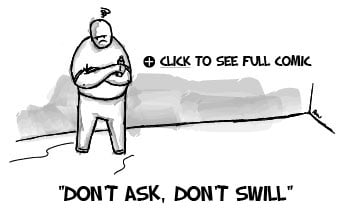It's expensive, wasteful and -- contrary to popular belief -- not any healthier for you than tap water.

BOTTLES, BOTTLES EVERYWHERE: Bottled water produces up to 1.5 million tons of plastic waste per year. (Photo:
quinn.anya/Flickr)
Bottled water is healthy water — or so marketers would have us believe. Just look at the labels or the bottled water ads: deep, pristine pools of spring water; majestic alpine peaks; healthy, active people gulping down icy bottled water between biking in the park and a trip to the yoga studio.
In reality, bottled water is just water. That fact isn't stopping people from buying a lot of it. Estimates variously place worldwide bottled water sales at between $50 and $100 billion each year, with the market expanding at the startling annual rate of 7 percent.
Bottled water is big business. But in terms of sustainability, bottled water is a dry well. It's costly, wasteful and distracts from the brass ring of public health: the construction and maintenance of safe municipal water systems.
Want some solid reasons to kick the bottled water habit? We've rounded up five to get you started.
1) Bottled water isn't a good value
Take, for instance, Pepsi's Aquafina or Coca-Cola's Dasani bottled water. Both are sold in 20 ounce sizes and can be purchased from vending machines alongside soft drinks — and at the same price. Assuming you can find a $1 machine, that works out to 5 cents an ounce. These two brands are essentially filtered tap water, bottled close to their distribution point. Most municipal water costs less than 1 cent per gallon.
Now consider another widely sold liquid: gasoline. It has to be pumped out of the ground in the form of crude oil, shipped to a refinery (often halfway across the world), and shipped again to your local filling station.
In the U.S., the average price per gallon is hovering around $3. There are 128 ounces in a gallon, which puts the current price of gasoline at a fraction over 2 cents an ounce.
And that's why there's no shortage of companies that want to get into the business. In terms of price versus production cost, bottled water puts Big Oil to shame.
2) No healthier than tap water
In theory, bottled water in the United States falls under the regulatory authority of the Food and Drug Administration. In practice, about 70 percent of bottled water never crosses state lines for sale, making it exempt from FDA oversight.
On the other hand, water systems in the developed world are well-regulated. In the U.S., for instance, municipal water falls under the purview of the Environmental Protection Agency, and is regularly inspected for bacteria and toxic chemicals. Want to know how your community scores? Check out the Environmental Working Group's
National Tap Water Database.
While public safety groups correctly point out that many municipal water systems are aging and there remain hundreds of chemical contaminants for which no standards have been established, there's very little empirical evidence that suggests bottled water is any cleaner or better for you than its tap equivalent.
3) Bottled water means garbage
Bottled water produces up to 1.5 million tons of plastic waste per year. According to
Food and Water Watch, that plastic requires up to 47 million gallons of oil per year to produce. And while the plastic used to bottle beverages is of high quality and in demand by recyclers, over 80 percent of plastic bottles are simply thrown away.
That assumes empty bottles actually make it to a garbage can. Plastic waste is now at such a volume that vast eddies of current-bound plastic trash now spin endlessly in the world's major oceans. This represents a
great risk to marine life, killing birds and fish which mistake our garbage for food.
Thanks to its slow decay rate, the vast majority of all plastics ever produced still exist — somewhere.
4) Bottled water means less attention to public systems
Many people drink bottled water because they don't like the taste of their local tap water, or because they question its safety.
This is like running around with a slow leak in your tire, topping it off every few days rather than taking it to be patched. Only the very affluent can afford to switch their water consumption to bottled sources. Once distanced from public systems, these consumers have little incentive to support bond issues and other methods of upgrading municipal water treatment.
There's plenty of need. In
California, for example, the
American Society of Civil Engineers estimated the requirement of $17.5 billion in improvements to the state's drinking water infrastructure as recently as 2005. In the same year, the state lost 222 million gallons of drinkable water to leaky pipes.
5) The corporatization of water
In the documentary film
Thirst, authors Alan Snitow and Deborah Kaufman demonstrated the rapid worldwide privatization of municipal water supplies, and the effect these purchases are having on local economies.
Water is being called the "Blue Gold" of the 21st century. Thanks to increasing urbanization and population, shifting climates and industrial pollution, fresh water is becoming humanity's most precious resource.
Multinational corporations are stepping in to purchase groundwater and distribution rights wherever they can, and the bottled water industry is an important component in their drive to commoditize what many feel is a basic human right: the access to safe and affordable water.
What can you do?
There's a simple alternative to bottled water: buy a stainless steel thermos, and use it. Don't like the way your local tap water tastes? Inexpensive carbon filters will turn most tap water sparkling fresh at a fraction of bottled water's cost.
Bottoms up!
Copyright Lighter Footstep 2008


 BOTTLES, BOTTLES EVERYWHERE: Bottled water produces up to 1.5 million tons of plastic waste per year. (Photo:
BOTTLES, BOTTLES EVERYWHERE: Bottled water produces up to 1.5 million tons of plastic waste per year. (Photo: